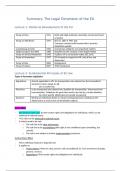Summary: The Legal Dimension of the EU
Lecture 1: Historical Development of the EU
Treaty of Paris 1951 ECSC with High Authority, Assembly, Council and Court
of Justice
Treaty on EEC/Rome 1957 Bel, NL, GER, IT, FRA, LUX
Common customs tariff towards third countries
EURATOM and EEC
Luxembourg Accords 1966 Unanimous voting for very important matters
Single European Act (SEA) 1986 Deadline for the creation of the Single Market
Treaty on the EU/Maastricht 1992 3 pillars, EP as co-decision maker, EEC to EC
Treaty of Amsterdam 1997 EU is based on respect for HR, rule of law, and
democracy
Treaty of Nice 2000 Enlargement
Treaty of Lisbon 2007 TFEU introduced
Lecture 2: Fundamental Principles of EU law
Types of Secondary Legislation
Regulations directly applicable in MS. No transposition into national law (but immediate).
General in nature (apply to all).
- aim at uniformity.
Directives to be transposed into national law. deadline for transposition. Instrument from
harmonization. Guidelines for goals that need to be met by a certain deadline.
- Can have specific addressees but usually are general.
Decisions Binding on individuals (both on natural and legal persons), binding on MS.
Addressed to a closed circle of identifiable subjects.
Direct Effect
- Van Gend en Loos Case: EU law creates rights and obligations for individuals, which can be
enforced in national courts.
- = EU rules can be enforced in national courts
- 3 criteria need to be met:
o The rule has to be clear and precise.
o The rule has to be unconditional (the right is not conditional upon something, but
overall).
o The rule is not subject to further implementation measures.
Vertical Direct Effect
- MS vs Individual (natural or legal person)
- It applies to:
o Treaty articles if they are clear, precise, and unconditional. Ex. Free movement of goods,
persons, services.
o Regulations if they create rights and obligations for individuals.
, o Directives that are not transposed in time or incorrectly and that create an
unconditional obligation that create rights for individuals.
Horizontal Direct Effect
- Two private individuals are in conflict. Ex. Company vs. Employee
- It applies to:
o Treaty articles if they are clear, precise, and unconditional.
o Regulations that create rights and obligation for individuals.
- It does not apply to Directives, but the state may be liable for damages.
Principle of Supremacy
- Costa v ENEL case: Community rules apply with the same force and with the same meaning and
effect for all who operate there.
- = if EU and national law are in conflict, then EU law is supreme
- Goal: uniform interpretation and application of EU law.
State Liability for Damages
- Francovich v. Italy case
- = right to compensation in case a directive is implemented incorrectly or late by a MS.
- Applies when:
o The directive creates rights and obligations.
o The content of the rights can be identified from the directive articles.
o The damage is a direct result of late or incorrect transposition (Causality).
Lecture 3: Primary and Secondary Legislation
Primary Legislation: Treaties, Charters: TEU. TFEU, ECHR
Secondary Legislation: created on the basis of primary legislation.
- Binding: Regulations, Directives, Decisions
- Non-Binding: Recommendations and Opinions
- Defined in Art. 288 TFEU
Acquis Communautaire: all that is acquired by the community.
EU Decision Making Principles
Loyalty: Art. 4(3) TEU 9o
- EU and MS shall assist each other and mutually respect each other.
- Spanish Strawberry Case: France: import of Spanish strawberries blocked by farmers.
Conferral: Art. 5(2) and 13(2) TEU
- The Union shall only act within the limits and competences conferred upon it by the MS in the
treaties.
- Need for a legal basis Art. 2-6 TFEU
- there is always the need for a legal basis Art 2-6 TFEU.
, - secondary legislation can be proposed if the Commission finds a treaty article to base it upon.
o exclusive competences: Art. 3 TFEU: ex. custom union, competition, monetary policy.
o shared competence: Art 4 TFEU: ex. internal market, environment.
o supporting or coordinating action: Art. 5 and 6 TFEU: ex. Tourism, culture, education.
“Sperrwirkung” = the EU locks a competence for MS while it legislates on it.
Subsidiarity: Art. 5(3) TEU
- = Decision should be made as close as possible to the citizen.
- Does not apply for exclusive competences.
Proportionality: Art. 5(4) TEU
- = Actions by the Union shall not exceed what is necessary to achieve the objective of the treaty.
- Choose the least restrictive measure.
Important Cases: General Principles
Van Gend en Loos A Dutch company challenged a Dutch customs decision Direct Effect
imposing a tariff on imports. The ECJ ruled that individual
rights could be directly invoked in national courts
Costa/ENEL Italian citizen challenged a national law that sought to Supremacy
nationalize the electricity industry. The ECJ ruled that the
laws of MS must yield to the supremacy of EU law.
Francovich Two Italian Air Force employees who lost their jobs when State Liability
their employer failed to implement an EU directive
concerning the protection of employees in the event of
insolvency. The ECJ ruled that member states could be held
liable for damages
Strawberry case French farmers sabotaged imported Spanish strawberries Loyalty
while French authorities turned a blind eye. The Commission
brought enforcement proceedings for ‘failing to take all
necessary and proportionate measures’ on the duty of
cooperation.
Lecture 4: Decision-Making Procedures
The Commissions Right of Initiative: Art 17 TEU
The Citizens Initiative: Art. 11(4) TEU and Art. 24 TFEU
- = Citizens can call on the Commission to initiate legislation.
- Signed by 1.000.000 EU citizens in 7 MS, within 1 year the Commission then organizes a
meeting and the EP a public hearing.
- However, the initiative is non-binding.
Decision-Making Procedures
More power to the Parliament:





